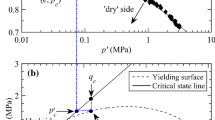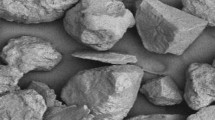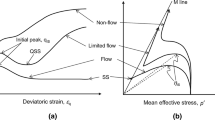Abstract
The stress–strain response of sand was observed to depend on its material state, i.e., pressure and density. Successful modelling of such state-dependent response of sand relied on the correct representation of its state-dependent stress–dilatancy behaviour. In this study, an improved fractional-order \(\left( \alpha \right)\) plasticity model for sands with a wide range of initial void ratios and pressures is proposed, based on a state-dependent fractional-order plastic flow rule and a modified yielding surface. Potential positive performances and negative limitations of the proposed approach in terms of the critical state of sand are discussed, based on the simulations of a series of drained and undrained triaxial tests of different sands. It can be found that unlike previous fractional models, the developed model can reasonably simulate the key features, e.g., strain softening/hardening, volumetric dilation/contraction, liquefaction, quasi-steady-state flow as well as steady-state flow, of sand for a wide range of initial states. However, due to typical forms of the critical-state lines being used, negative performances of the fractional approach could occur when simulating the undrained behaviour of very loose sand and the drained behaviour of very dense sand.
















Similar content being viewed by others
References
Agrawal OP (2007) Fractional variational calculus in terms of Riesz fractional derivatives. J Phys A Math Theor 40(24):6287–6303
Alipour MJ, Lashkari A (2018) Sand instability under constant shear drained stress path. Int J Solids Struct 150:66–82. https://doi.org/10.1016/j.ijsolstr.2018.06.003
Azizi A (2009) Experimental study and modeling behavior of granular materials in constant deviatoric stress loading. Amirkabir University of Technology, Iran
Bandini V, Coop MR (2011) The influence of particle breakage on the location of the critical state line of sands. Soils Found 51(4):591–600
Bardet JP (1986) Bounding surface plasticity model for sands. J Eng Mech 112(11):1198–1217. https://doi.org/10.1061/(ASCE)0733-9399(1986)112:11(1198)
Been K, Jefferies MG (1985) A state parameter for sands. Géotechnique 35(2):99–112. https://doi.org/10.1016/0148-9062(85)90263-3
Been K, Jefferies MG (2004) Stress dilatancy in very loose sand. Can Geotech J 41(5):972–989. https://doi.org/10.1139/t04-038
Caputo M (1967) Linear models of dissipation whose Q is almost frequency independent—II. Geophys J Int 13(5):529–539. https://doi.org/10.1111/j.1365-246X.1967.tb02303.x
Caputo M, Fabrizio M (2015) Damage and fatigue described by a fractional derivative model. J Comput Phys 293:400–408. https://doi.org/10.1016/j.jcp.2014.11.012
Cen WJ, Luo JR, Bauer E, Zhang WD (2018) Generalized plasticity model for sand with enhanced state parameters. J Eng Mech 144(12):04018108. https://doi.org/10.1061/(ASCE)EM.1943-7889.0001534
Choo J (2018) Mohr–Coulomb plasticity for sands incorporating density effects without parameter calibration. Int J Numer Anal Methods Geomech. https://doi.org/10.1002/nag.2851
Ciantia MO, Arroyo M, O’Sullivan C, Gens A, Liu T (2018) Grading evolution and critical state in a discrete numerical model of Fontainebleau sand. Géotechnique. https://doi.org/10.1680/jgeot.17.p.023
Dafalias YF, Manzari MT (2004) Simple plasticity sand model accounting for fabric change effects. J Eng Mech 130(6):622–634. https://doi.org/10.1061/(ASCE)0733-9399(2004)130:6(622)
Eslami MM, Pradel D, Brandenberg SJ (2018) Experimental mapping of elastoplastic surfaces for sand using undrained perturbations. Soils Found 58(1):160–171. https://doi.org/10.1016/j.sandf.2017.12.004
Feia S, Sulem J, Canou J, Ghabezloo S, Clain X (2014) Changes in permeability of sand during triaxial loading: effect of fine particles production. Acta Geotech 1:19. https://doi.org/10.1007/s11440-014-0351-y
Gajo A, Muir Wood D (1999) A kinematic hardening constitutive model for sands: the multiaxial formulation. Int J Numer Anal Methods Geomech 23(9):925–965. https://doi.org/10.1002/(SICI)1096-9853(19990810)23:9%3c925:AID-NAG19%3e3.0.CO;2-M
Gajo A, Muir Wood D (1999) SevernTrent sand: a kinematic-hardening constitutive model: the q − p formulation. Géotechnique 49(5):595–614
Golchin A, Lashkari A (2014) A critical state sand model with elastic–plastic coupling. Int J Solids Struct 51(15):2807–2825. https://doi.org/10.1016/j.ijsolstr.2014.03.032
Heidarzadeh H, Oliaei M (2018) Development of a generalized model using a new plastic modulus based on bounding surface plasticity. Acta Geotech 13(4):925–941. https://doi.org/10.1007/s11440-017-0599-0
Ishihara K, Tatsuoka F, Yasuda S (1975) Undrained deformation and liquefaction of sand under cyclic stresses. Soils Found 15(1):29–44. https://doi.org/10.3208/sandf1972.15.29
Jin Y, Wu Z, Yin Z, Shen JS (2017) Estimation of critical state-related formula in advanced constitutive modeling of granular material. Acta Geotech 12(6):1329–1351. https://doi.org/10.1007/s11440-017-0586-5
Jocković S, Vukićević M (2017) Bounding surface model for overconsolidated clays with new state parameter formulation of hardening rule. Comput Geotech 83:16–29. https://doi.org/10.1016/j.compgeo.2016.10.013
Kan M, Taiebat H, Khalili N (2014) Simplified mapping rule for bounding surface simulation of complex loading paths in granular materials. Int J Geomech 14(2):239–253. https://doi.org/10.1061/(ASCE)GM.1943-5622.0000307
Kang X, Xia Z, Chen R, Ge L, Liu X (2019) The critical state and steady state of sand: a literature review. Mar Georesour Geotechnol 37:1–14
Khalili N, Habte MA, Valliappan S (2005) A bounding surface plasticity model for cyclic loading of granular soils. Int J Numer Methods Eng 63(14):1939–1960. https://doi.org/10.1002/nme.1351
Lade PV, Nelson RB, Ito YM (1987) Nonassociated flow and stability of granular materials. J Eng Mech 113(9):1302–1318. https://doi.org/10.1061/(ASCE)0733-9399(1987)113:9(1302)
Lee KL, Seed HB (1967) Drained strength characteristics of sands. J Soil Mech Found Div 93(6):117–141
Li X (2002) A sand model with state-dependent dilatancy. Géotechnique 52(3):173–186
Li X, Dafalias Y (2000) Dilatancy for cohesionless soils. Géotechnique 50(4):449–460. https://doi.org/10.1680/geot.2000.50.4.449
Li X, Wang Y (1998) Linear representation of steady-state line for sand. J Geotech Geoenviron Eng 124(12):1215–1217. https://doi.org/10.1061/(ASCE)1090-0241(1998)124:12(1215)
Liu M, Gao Y (2016) Constitutive modeling of coarse-grained materials incorporating the effect of particle breakage on critical state behavior in a framework of generalized plasticity. Int J Geomech 17(5):04016113. https://doi.org/10.1061/(ASCE)GM.1943-5622.0000759
Liu HB, Zou DG (2013) Associated generalized plasticity framework for modeling gravelly soils considering particle breakage. J Eng Mech 139(5):606–615. https://doi.org/10.1061/(ASCE)EM.1943-7889.0000513
Liu HB, Zou DG, Liu JM (2014) Constitutive modeling of dense gravelly soils subjected to cyclic loading. Int J Numer Anal Methods Geomech 38(14):1503–1518. https://doi.org/10.1002/nag.2269
Liu M, Zhang Y, Zhu H (2017) 3D elastoplastic model for crushable soils with explicit formulation of particle crushing. J Eng Mech 143(12):04017140. https://doi.org/10.1061/(ASCE)EM.1943-7889.0001361
Lu D, Liang J, Du X, Ma C, Gao Z (2019) Fractional elastoplastic constitutive model for soils based on a novel 3D fractional plastic flow rule. Comput Geotech 105:277–290. https://doi.org/10.1016/j.compgeo.2018.10.004
Lü X, Huang M, Andrade JE (2018) Modeling the static liquefaction of unsaturated sand containing gas bubbles. Soils Found 58(1):122–133. https://doi.org/10.1016/j.sandf.2017.11.008
McDowell G (2002) A simple non-associated flow model for sand. Granul Matter 4(2):65–69
McDowell G, de Bono JP (2013) On the micro mechanics of one-dimensional normal compression. Géotechnique 63(11):895–908
McDowell GR, Yue P, de Bono JP (2015) Micro mechanics of critical states for isotropically overconsolidated sand. Powder Technol 283:440–446. https://doi.org/10.1016/j.powtec.2015.05.043
Meghachou M (1992) Stabilitédes sables laches: essais et modélisations. Université d’Oran
Pastor M, Zienkiewicz OC, Chan AHC (1990) Generalized plasticity and the modelling of soil behaviour. Int J Numer Anal Methods Geomech 14(3):151–190. https://doi.org/10.1002/nag.1610140302
Pedroso DM, Sheng DC, Zhao JD (2009) The concept of reference curves for constitutive modeling in soil mechanics. Comput Geotech 36(1):149–165
Pestana JM, Whittle AJ (1995) Compression model for cohesionless soils. Géotechnique 45(4):611–631
Podlubny I (1998) Fractional differential equations: an introduction to fractional derivatives, fractional differential equations, to methods of their solution and some of their applications, vol 198. Mathematics in science and engineering. Academic Press, San Diego
Russell A, Khalili N (2002) Drained cavity expansion in sands exhibiting particle crushing. Int J Numer Anal Methods Geomech 26(4):323–340
Russell AR, Khalili N (2004) A bounding surface plasticity model for sands exhibiting particle crushing. Can Geotech J 41(6):1179–1192
Russell A, Khalili N (2006) A unified bounding surface plasticity model for unsaturated soils. Int J Numer Anal Methods Geomech 30(3):181–212
Schofield A, Wroth P (1968) Critical state soil mechanics. McGraw-Hill, New York
Shi XS, Herle I (2017) Numerical simulation of lumpy soils using a hypoplastic model. Acta Geotech 12(2):349–363. https://doi.org/10.1007/s11440-016-0447-7
Shi XS, Herle I, Muir Wood D (2017) A consolidation model for lumpy composite soils in open-pit mining. Géotechnique 68(3):189–204. https://doi.org/10.1680/jgeot.16.P.054
Shi XS, Herle I, Yin J (2018) Laboratory study of the shear strength and state boundary surface of a natural lumpy soil. J Geotech Geoenviron Eng 144(12):04018093. https://doi.org/10.1061/(ASCE)GT.1943-5606.0001987
Sumelka W (2014) Fractional viscoplasticity. Mech Res Commun 56:31–36. https://doi.org/10.1016/j.mechrescom.2013.11.005
Sumelka W, Nowak M (2016) Non-normality and induced plastic anisotropy under fractional plastic flow rule: a numerical study. Int J Numer Anal Methods Geomech 40(5):651–675. https://doi.org/10.1002/nag.2421
Sumelka W, Nowak M (2018) On a general numerical scheme for the fractional plastic flow rule. Mech Mater 116:120–129. https://doi.org/10.1016/j.mechmat.2017.02.005
Sun Y, Sumelka W (2019) State-dependent fractional plasticity model for the true triaxial behaviour of granular soil. Arch Mech 71(1):23–47. https://doi.org/10.24423/aom.3084
Sun Y, Sumelka W (2019) Fractional viscoplastic model for soils under compression. Acta Mech. https://doi.org/10.1007/s00707-019-02466-z
Sun Y, Xiao Y (2017) Fractional order plasticity model for granular soils subjected to monotonic triaxial compression. Int J Solids Struct 118–119:224–234. https://doi.org/10.1016/j.ijsolstr.2017.03.005
Sun Y, Indraratna B, Carter JP, Marchant T, Nimbalkar S (2017) Application of fractional calculus in modelling ballast deformation under cyclic loading. Comput Geotech 82:16–30. https://doi.org/10.1016/j.compgeo.2016.09.010
Sun Y, Gao Y, Zhu Q (2018) Fractional order plasticity modelling of state-dependent behaviour of granular soils without using plastic potential. Int J Plasticity 102:53–69. https://doi.org/10.1016/j.ijplas.2017.12.001
Sun Y, Chen C, Song S (2018) Generalized fractional flow rule and its modelling of the monotonic and cyclic behavior of granular soils. In: Zhou A, Tao J, Gu X, Hu L (eds) Proceedings of GeoShanghai 2018 international conference: fundamentals of soil behaviours, Singapore, 2018//2018. Springer, Singapore, pp 299–307
Sun Y, Gao Y, Shen Y (2019) Mathematical aspect of the state-dependent stress-dilatancy of granular soil under triaxial loading. Géotechnique 69(2):158–165. https://doi.org/10.1680/jgeot.17.t.029
Sun Y, Gao Y, Song S, Chen C (2019) Three-dimensional state-dependent fractional plasticity model for soils. Int J Geomech. https://doi.org/10.1061/(ASCE)GM.1943-5622.0001353
Taiebat M, Jeremić B, Dafalias YF, Kaynia AM, Cheng Z (2010) Propagation of seismic waves through liquefied soils. Soil Dyn Earthq Eng 30(4):236–257. https://doi.org/10.1016/j.soildyn.2009.11.003
Verdugo R, Ishihara K (1996) The steady state of sandy soils. Soils Found 36(2):81–91. https://doi.org/10.3208/sandf.36.2_81
Wan R, Guo P (1998) A simple constitutive model for granular soils: modified stress-dilatancy approach. Comput Geotech 22(2):109–133. https://doi.org/10.1016/s0266-352x(98)00004-4
Wan R, Nicot F, Darve F (2009) Micromechanical formulation of stress dilatancy as a flow rule in plasticity of granular materials. J Eng Mech 136(5):589–598. https://doi.org/10.1061/(ASCE)EM.1943-7889.0000105
Wang Z, Dafalias Y, Li X, Makdisi F (2002) State pressure index for modeling sand behavior. J Geotech Geoenviron Eng 128(6):511–519. https://doi.org/10.1061/(ASCE)1090-0241(2002)128:6(511)
Xiao Y, Liu H (2016) Elastoplastic constitutive model for rockfill materials considering particle breakage. Int J Geomech 17(1):04016041. https://doi.org/10.1061/(ASCE)GM.1943-5622.0000681
Xiao Y, Liu H, Chen Y, Jiang J (2014) Bounding surface plasticity model incorporating the state pressure index for rockfill materials. J Eng Mech 140(11):04014087. https://doi.org/10.1061/(ASCE)EM.1943-7889.0000802
Xiao Y, Liu H, Chen Y, Jiang J (2014) Bounding surface model for rockfill materials dependent on density and pressure under triaxial stress conditions. J Eng Mech 140(4):04014002. https://doi.org/10.1061/(ASCE)EM.1943-7889.0000702
Xiao Y, Sun Y, Yin F, Liu H, Xiang J (2017) Constitutive modeling for transparent granular soils. Int J Geomech 17(7):04016150. https://doi.org/10.1061/(ASCE)GM.1943-5622.0000857
Xiao Y, Sun Z, Stuedlein AW, Wang C, Wu Z, Zhang Z (2019) Bounding surface plasticity model for stress–strain and grain-crushing behaviors of rockfill materials. Geosci Front. https://doi.org/10.1016/j.gsf.2018.1010.1010
Yao Y, Wang N (2014) Transformed stress method for generalizing soil constitutive models. J Eng Mech 140(3):614–629. https://doi.org/10.1061/(ASCE)EM.1943-7889.0000685
Yao YP, Sun DA, Luo T (2004) A critical state model for sands dependent on stress and density. Int J Numer Anal Methods Geomech 28(4):323–337. https://doi.org/10.1002/nag.340
Yao YP, Hou W, Zhou AN (2009) UH model: three-dimensional unified hardening model for overconsolidated clays. Géotechnique 59(5):451–469. https://doi.org/10.1680/geot.2007.00029
Yao YP, Kong L, Zhou A, Yin J (2014) Time-dependent unified hardening model: three-dimensional elastoviscoplastic constitutive model for clays. J Eng Mech 141(6):04014162. https://doi.org/10.1061/(ASCE)EM.1943-7889.0000885
Yao YP, Liu L, Luo T, Tian Y, Zhang JM (2019) Unified hardening (UH) model for clays and sands. Comput Geotech 110:326–343. https://doi.org/10.1016/j.compgeo.2019.02.024
Yin Z, Wu Z, Hicher P (2018) Modeling monotonic and cyclic behavior of granular materials by exponential constitutive function. J Eng Mech 144(4):04018014. https://doi.org/10.1061/(ASCE)EM.1943-7889.0001437
Yu F (2017) Particle breakage and the critical state of sands. Géotechnique 67(8):713–719. https://doi.org/10.1680/jgeot.15.P.250
Acknowledgements
The first author would like to appreciate Prof. Wen Chen for his lifelong inspiration. The financial support provided by the National Key R&D Program of China (2016YFC0800205) National Natural Science Foundation of China (Grant Nos. 41630638, 51890912, 51808191), the National Key Basic Research Program of China (“973” Program) (Grant No. 2015CB057901) and the Humboldt Research Foundation, Germany, is appreciated. The second author also acknowledges the support of the National Science Centre, Poland, under Grant No. 2017/27/B/ST8/00351.
Author information
Authors and Affiliations
Corresponding author
Additional information
Publisher's Note
Springer Nature remains neutral with regard to jurisdictional claims in published maps and institutional affiliations.
Appendix
Appendix
In order to derive Eq. (17), the following analytical solutions of the power-law functions, \((\sigma^{\prime} - \sigma^{\prime}_{{\mathrm{c}}} )^{\mu }\) and \((\sigma^{\prime}_{{\mathrm{c}}} - \sigma^{\prime})^{\mu }\), are needed:
where \(\mu\) is the power index. Details for deriving Eqs. (25) and (26) can be found in [44] and thus not repeated here for simplicity. Accordingly, Eq. (14) with \(\beta = 0\) should be rearranged as:
and
Then, substituting Eqs. (27) and (28) into Eqs. (25) and (26), respectively, one has:
Further substituting Eq. (2) into Eqs. (29) and (30), a unique stress–dilatancy equation is obtained:
Rights and permissions
About this article
Cite this article
Sun, Y., Sumelka, W. & Gao, Y. Advantages and limitations of an α-plasticity model for sand. Acta Geotech. 15, 1423–1437 (2020). https://doi.org/10.1007/s11440-019-00877-9
Received:
Accepted:
Published:
Issue Date:
DOI: https://doi.org/10.1007/s11440-019-00877-9




